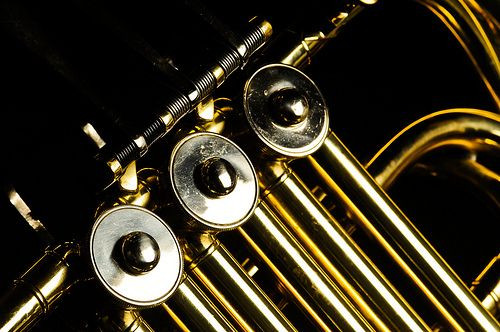French Horn Players Most Likely In Orchestra To Suffer From Hearing Loss; Only 18% Use Ear Protection

Perhaps you’d think it was the conductor, with a literal symphony blasting in his or her face for hours. But a new study finds that French horn players suffer the greatest risk for hearing loss and damage among a given orchestra.
Australian researchers, publishing in the Journal of Occupational and Environmental Hygiene, investigated the noise-induced hearing loss (NIHL) conservation practices of 144 French horn players attending a 2010 international horn conference in Brisbane, Australia. Despite facing a great occupational hazard, very few, if any, musicians used some form of hearing protection, and up to one-third surveyed experienced some form of hearing loss or damage.
The overall rates of hearing loss hovered between 11 and 22 percent. That statistic rose when the researchers singled out horn players 40 years and younger — up to between 18 and 33 percent. Among these, only 18 percent used a form of hearing protection, including ear plugs, foam, or other inferior means.
"Even within that 18 percent, the use of hearing protection appears to be inadequate,” lead investigator Wayne Wilson, a senior lecturer in audiology at the University of Queensland, said in a news release, “with 81 percent of these participants reporting their frequency of use as 'sometimes' and 50 percent reporting they use generic, foam or other inferior forms of protection.”
Horn players face a greater risk for hearing loss simply because of the instrument that they play, although musicians in general tend to face more occupational hazards for NIHL. One 2010 study found that orchestra members were exposed to 81-90 decibels (dB) for 21-48 hours per week, despite many countries legislating the safe threshold for loudness at 85 dB for 30 minutes a day. Over 40 years, at concerts lasting as long as some sporting events, the potential for hearing loss skyrockets.
The 2010 study found “about 46% of respondents noticed hearing impairment,” and “nearly every fifth musician complained of tinnitus while almost half (48%) of them–of hyperacusis,” the researchers wrote. Clarinetists faced a 33 percent risk for NIHL, and rates went up from there: tuba players, 34 percent; trumpet players, 37 percent; trombonists, 40 percent; percussionists, 41 percent; and horn players, at the top, at 47 percent.
A total 46 percent of all study participants reported hearing damage, most often tinnitus or hyperacusis.
Tinnitus is a ringing in the ears when no sound is present. The most common cause is NIHL, but tinnitus can arise from underlying neurological damage, ear infections, or relatively minor causes, such as wax buildup and nasal allergies. Hyperacusis is an oversensitivity to certain sound frequencies, which may seem painfully loud to the observer but normal to others.
According to the latest study’s researchers, NIHL can and should be prevented as long as musicians understand the occupational risks of playing loud music for sustained period of time. A musician’s ear is his or her greatest tool in playing an instrument correctly, so failing to protect it where it most often performs has the potential for self-defeat.
The findings “reinforce the need to educate horn players, their mentors and audiologists about the need to protect hearing and how best to achieve this while still enabling musicians to play to the highest level," study author Ian O'Brien, a doctoral degree candidate at the University of Sydney and a professional French horn player, said in the news release.
"Even mild hearing loss,” he added, “can result in difficulties discriminating pitch, abnormal loudness growth, and tinnitus, all of which can affect a musician's ability to perform, subsequently jeopardizing his or her livelihood.”
Source: Wilson W, O'Brien I, Bradley A. The Audiological Health of Horn Players. Journal of Occupational and Environmental Hygiene. 2013.



























